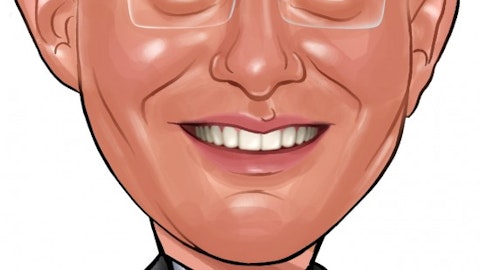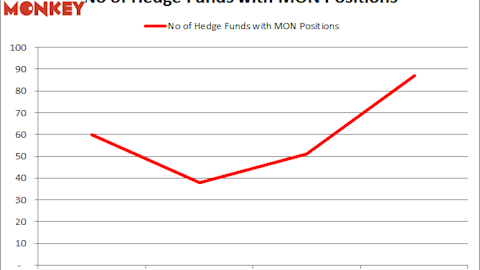7: Canadian National Railway (USA) (NYSE:CNI)
Percent of Bill Gates’ Portfolio: 6.1%
Dividend Yield: 1.8% Forward P/E Ratio: 17.2x (as of 11/18/16)
Sector: Transportation Industry: Rail Transportation
Canadian National Railway’s roots can be traced back to the early 1900s. The company was formed through the combination of several financially-challenged railways and was later privatized in 1995.
The company owns and operates roughly 20,000 miles of railroads running across Canada and mid-America. Its network connects the Atlantic, the Pacific, and the Gulf of Mexico.
Each year, Canadian National Railway handles over $250 billion worth of goods and transports more than 300 million tons of cargo for importers, exporters, farmers, retailers, and manufacturers.
By commodity group, 24% of the company’s freight revenue is intermodal, 21% oil & chemicals, 17% grain & fertilizer, 15% forest products, 12% metals & minerals, 6% automotive, and 5% coal.
Roughly one third of the company’s revenue is generated from transborder traffic, 31% overseas traffic, 18% U.S. domestic traffic, and 18% Canadian domestic traffic.
Why does Bill Gates have a large stake in the company? Railroads have proven to be extremely durable businesses for several reasons.
First, they own hard-to-replicate assets. There are only so many railway lines that are needed in the country, and incumbent operators already control the most valuable routes. For example, Canadian National Railway can reach close to 75% of the population in North America with its railway network.
Railroad operators routinely invest close to 20% of their revenue back into capital equipment to keep their lines safe and efficient. Smaller companies cannot afford these massive capital outlays.
The industry has also consolidated to further improve productivity and make it more challenging for new entrants to gain a foothold. The three largest U.S. railroad operators account for more than 60% of total rail miles in the country, for example.
As a result of the industry’s consolidation, hard-to-replicate assets, and essential supply chain services, railways have consistently increased prices by 2-4% per year.
Canadian National Railway (USA) (NYSE:CNI) is one of the most productive railway operator in the country and will remain relevant for a very long time.
Warren Buffett also loves railroad operators and acquired Burlingon Northern Santa Fe (BNSF) in 2010 for $34 billion, adding the company to Berkshire Hathaway’s portfolio of dividend stocks.
Turning to the dividend, Canadian National Railway has raised its dividend every year since it went public in 1995. Over that time period, the company’s dividend has compounded by 17% per year.
Despite the slump in commodities earlier this year, Canadian National Railway (USA) (NYSE:CNI) raised its dividend by 20% earlier this year and should continue enjoying strong growth.
Management recently increased the company’s target payout ratio to 35%, which will allow the dividend to grow faster than underlying earnings for a few years to approach its new payout target. Double-digit dividend growth could continue.
Follow Canadian National Railway Co (NYSE:CNI)
Follow Canadian National Railway Co (NYSE:CNI)
8: Walgreens Boots Alliance Inc (NASDAQ:WBA)
Percent of Bill Gates’ Portfolio: 1.5%
Dividend Yield: 1.8% Forward P/E Ratio: 16.5x (as of 11/18/16)
Sector: Consumer Discretionary Industry: Drug Store
Walgreens Boots Alliance Inc (NASDAQ:WBA) is a global leader in the retail pharmacy market and has more than 13,100 stores in 11 countries. The company’s drugstores sell a wide variety of prescription and non-prescription drugs in addition to consumer products in categories such as beauty, personal care, and grocery.
Walgreens has three business segments. Retail Pharmacy USA accounts for close to 70% of segment income and consists of Walgreens and Duane Reade branded drugstores in the U.S.
Retail Pharmacy International accounts for just fewer than 20% of segment profits and consists of Alliance Boots, one of the largest drugstores in Europe that Walgreens fully acquired in 2014.
Walgreen’s final segment is Pharmaceutical Wholesale, which accounts for about 10% of segment income and supplies medicines and a variety of healthcare products to more than 200,000 pharmacies and other healthcare institutions from more than 350 distribution centers.
Walgreens likely appeals to Bill Gates for several reasons. Increased regulation and falling government reimbursements have put tremendous pressure on companies to take costs out of the healthcare system. As a result, the industry has been consolidating.
Walgreens bought Duane Reade for $1.1 billion in 2010 and acquired a 45% stake in Alliance Boots for $6.7 billion in 2012. The company purchased the rest of Alliance Boots in 2014 to give it a presence in faster-growing international markets and further expand its scale.
With Alliance Boots, Walgreens became the biggest purchaser of generic drugs in the world.
Most recently, Walgreens announced a deal to acquire Rite-Aid for $17.2 billion in 2015. Assuming the deal closes in late 2016, Walgreens will be able to provide better national coverage for its customers.
By acquiring other drugstores, Walgreens gains substantial cost synergies from procurement savings on the purchase of drugs and merchandise. The company’s economies of scale allow it to offer customers lower costs compared to its smaller rivals.
In addition to economies of scale, Walgreens owns some of the best real estate in the country. More than 75% of the U.S. population lives within five miles of a Walgreens or Duane Reade retail pharmacy, and that number will move up after the Rite-Aid acquisition closes.
It’s easy to understand why Walgreens has one of the most valuable brands in the world.
Finally, Michael Larson might also like Walgreens because the company should benefit as healthcare spending continues to rise to support the growing elderly population and number of insured citizens.
Walgreens Boots Alliance Inc (NASDAQ:WBA) dividend growth story has been nothing short of outstanding, too. The company has increased its dividend for 40 consecutive years and paid uninterrupted dividends for 83 straight years.
The company’s dividend has compounded by 20% per year over its last 10 fiscal years and should continue enjoying strong growth thanks to its low payout ratio and predictable business model.
Follow Walgreens Boots Alliance Inc. (NASDAQ:WBA)
Follow Walgreens Boots Alliance Inc. (NASDAQ:WBA)





